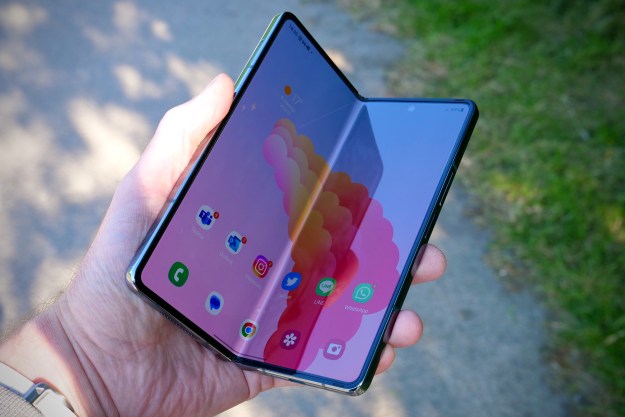Internet access is fast becoming a basic human right, but there are problems with our current delivery systems. As we connect more and more devices to the internet, a spectrum crunch is increasingly inevitable. Li-Fi, which allows us to access the internet via light, instead of the radio frequencies that Wi-Fi relies upon, could open up a lot of bandwidth.
You may remember that we talked to Edinburgh-based PureLiFi last year to see a working prototype of its LiFi-X system. This year at MWC in Barcelona, we sat down again with PureLi-Fi COO Harald Burchardt to find out how far the team has come in the last 12 months. As it turns out, the company has been busy raising significant funding, expanding the engineering team, and securing more partners.
What is Li-Fi?
The LiFi-X system consists of an LED light fixture and a dongle that you can plug into a USB port on your laptop. It’s capable of delivering speeds of up to 42Mbps up and down. It’s already available and in use through various business partnerships.
PureLiFi has been working with a number of companies worldwide, including Cisco, British Telecom, and Babcock, to trial the technology and gather feedback for improvements. There are lots of reasons that a company might consider a Li-Fi system.
The LiFi-X dongles and LED light fixtures send and receive data through light.
“We work with a lot of companies where security is high on their agenda; for the enterprise, bandwidth is a big thing, but also location for retail and financial services,” Burchardt told Digital Trends.
The LiFi-X dongles and LED light fixtures send and receive data through light. That means you can confine access to the network very easily, offering much greater security than Wi-Fi.
In order to get the light working, you need to hook it up in much the same way as you would a router. This is ideally achieved through Ethernet cabling, though it can also be retrofitted using existing power lines. The weakness of power line communications is that the lights are in a daisy chain, so you’re dividing the bandwidth between them. With Ethernet cabling, each individual light is hooked up directly.
PoE (Power over Ethernet) systems are actually growing in popularity because they offer very high-efficiency power and, since they don’t require a certified electrician to fit them, they’re also faster and cheaper to install. Having IP connectivity in every light fixture also offers benefits in terms of building control and device monitoring, which is growing more important as the IoT expands.
In the short term, PureLiFi is working on establishing a set of performance standards. It expects to hit speeds of 80 to 100 Mbps in the future, and will then look to push things further to 1 Gbps.
Li-Fi might be in your phone one day
A lot of effort is also going into miniaturizing the technology. The current LiFi-X dongle is quite big, it’s suitable for a laptop, but probably too bulky for comfortable use with a tablet. We got a sneak peek at the newly redesigned dongle, which is coming in the second half of this year. We weren’t allowed to photograph it, but compared to the existing LiFi –X, it is much smaller. Imagine a sleek, stylish-looking USB thumb drive and you’re close. That’s a significant improvement, but it’s still not going to work for smaller devices, like our phones.
Rumors have already circulated about Li-Fi support in a future iPhone.
“We are currently working on ways to reduce the size of the optical receiver so that it can fit in a smartphone,” says Burchardt.
It may be part of the phone, or something separate about the size of a camera module.
“We are already in discussions with a number of manufacturers of smartphones, tablets, and laptops and the goal is to get to that stage where we’re developing chips that will go into the device,” Burchardt explained. “Our long-term goal is component supply for OEMs.”
PureLiFi remains tight-lipped about who the prospective partners are, but rumors have already circulated about Li-Fi support in a future model of Apple’s iPhone, after a reference to “LiFiCapability” was spotted in iOS code.
Businesses can talk to PureLiFi now and get to work implementing the technology, but if you’re clamoring for a consumer product, you’ll need to be patient for a while longer.
“Probably within the next three years we’ll have components available that can be technically integrated into a phone,” says Burchardt.
The future is bright for Li-Fi
By that time, the underlying infrastructure of Ethernet cabling, required for peak performance of Li-Fi, is likely to be far more widespread. PureLiFi is also working with a number of partners in the lighting industry, so the ecosystem required for Li-Fi to thrive is already growing. Component costs will also come down, as manufacturing ramps up, making it affordable for OEMs to integrate.
“We plan to provide components that are very low power, very cost effective, and very high performance,” says Burchardt.
The exponential growth in connected devices and data demands is leading to frequency congestion and that could make current wireless technologies unsustainable in the long term. Li-Fi can make much greater volumes of data accessible, and securing access is as simple as pulling the shades. The future looks bright for Li-Fi.







